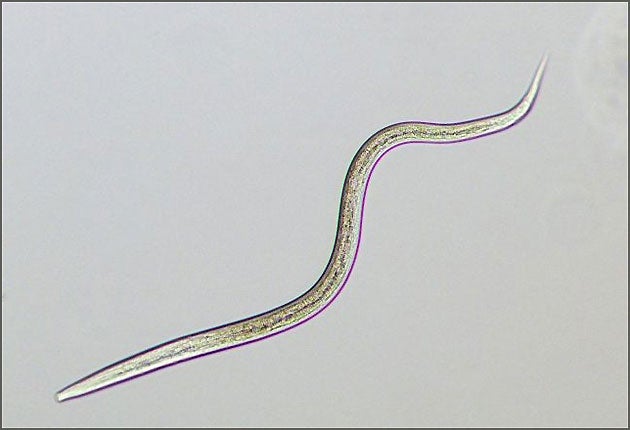Boldly going where no worms have been before

Your support helps us to tell the story
From reproductive rights to climate change to Big Tech, The Independent is on the ground when the story is developing. Whether it's investigating the financials of Elon Musk's pro-Trump PAC or producing our latest documentary, 'The A Word', which shines a light on the American women fighting for reproductive rights, we know how important it is to parse out the facts from the messaging.
At such a critical moment in US history, we need reporters on the ground. Your donation allows us to keep sending journalists to speak to both sides of the story.
The Independent is trusted by Americans across the entire political spectrum. And unlike many other quality news outlets, we choose not to lock Americans out of our reporting and analysis with paywalls. We believe quality journalism should be available to everyone, paid for by those who can afford it.
Your support makes all the difference.Thousands of microscopic worms took to the skies as part of a space mission, a university said today.
The worms were on board when the Space Shuttle Atlantis launched from Cape Canaveral last night.
The unexpected astronauts will help experts in human physiology at the University of Nottingham understand more about what triggers the body to build and lose muscle.
The worms are bound for the Japanese Experiment Module "Kibo" on the International Space Station (ISS) where they will experience the same weightless conditions which can cause dramatic muscle loss in astronauts.
The Kibo lab makes use of the weightless conditions in orbit for the study of biomedicine and material sciences.
The worms are used by Dr Nathaniel Szewczyk, from the university's Institute of Clinical Research in Derby, to study the signals that control muscle protein degradation.
He uses the microscopic worm Caenorhabditis elegans (C. elegans), because they are the perfect substitute for studying long term changes in human physiology - suffering from muscle loss under many of the same conditions that people do.
Muscle loss, or muscle atrophy, is one of the major health concerns for astronauts.
The research is also hoped to help scientists understand more about the condition which also affects the bedridden, people with muscular dystrophy and diabetes, people immobilised by casts and the elderly.
The worms, traced back to a rubbish dump in Bristol, often feed on bacteria that develop on decaying vegetable matter.
Their predecessors made news in 2003 when they survived the Space Shuttle Columbia disaster, including re-entry and impact, and were recovered weeks after the disaster.
Dr Szewczyk, who has carried out three previous space worm missions, is working with Professor Atsushi Higashitani from Tohoku University, Sendai, Japan.
Professor Higashitani is the Principal Investigator of the CERISE (C. Elegans RNAi In Space Experiment) payload and will be based in Florida during the flight to co-ordinate the payload's experiments.
Dr Szewczyk said: "We can learn things in space that we would not be able to learn on earth.
"If we can identify what causes the body to react in certain ways in space we establish new pathways for research back on earth."
C. elegans was the first multi-cellular organism to have its genetic structure completely mapped and many of its 20,000 genes perform the same functions as those in humans.
Dr Szewczyk's researcher Dr Tim Etheridge has been given the task of preparing the worms for their journey to the International Space Station, roughly 200 miles from the Earth.
They have been carefully selected and brought to a dormant state for the journey, travelling in special cell culture bags.
They will be brought back from their dormant state with the release of food, exposed to conditions in space for four days and then frozen in preparation for the return journey.
The effect of this journey on their muscle mass will be investigated once the worms are returned to the university's laboratories in Derby.
Dr Szewczyk said: "The CERISE payload is an important space medicine experiment as it will establish if RNAi, which was the subject of the 2006 Nobel Prize in Medicine, is a viable technique for altering the biological response to spaceflight.
"For example, some of our worms will be treated with RNAi against specific proteases to see if we can stop muscle protein degradation in space."
The worms will be on board Space Shuttle Atlantis when it takes off from the Kennedy Space Centre today at 2.28pm local time (7.28pm GMT).
Both Dr Szewczyk and Dr Etheridge have travelled to Florida to see the worms safely onboard the space shuttle.
Join our commenting forum
Join thought-provoking conversations, follow other Independent readers and see their replies
Comments